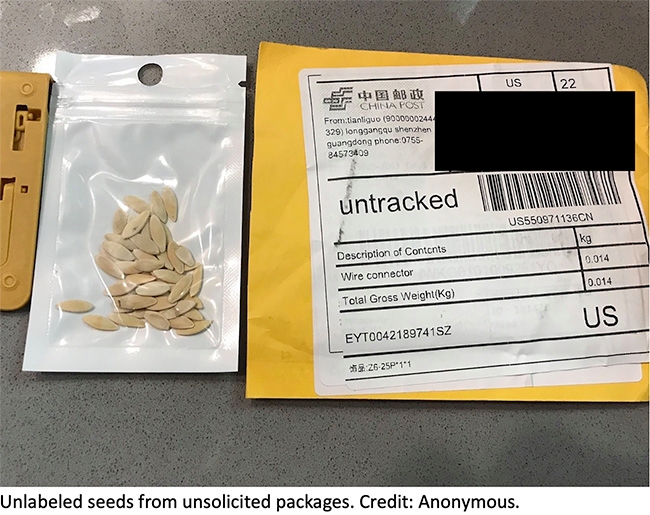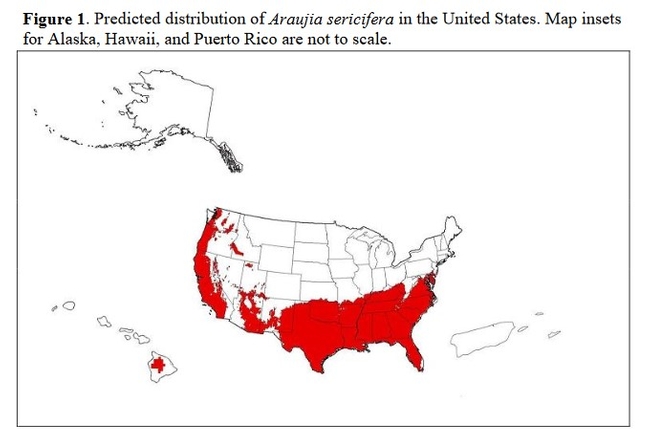
Posts Tagged: Invasive
Invasive Goldspotted Borer Hits California Oaks
By Julie Clark, Community Education Specialist III
Goldspotted borer (GSOB) is a beetle invasive to oaks in California. Infestations have ravaged oak woodlands in San Diego and Riverside counties the last 12 years and in Anaheim Hills, Angeles and San Bernardino National Forests the last few years. Preferred hosts are black oak, canyon oak, coast live oak, and occasionally Engelmann oak.
Oak woodlands are highly valued ecosystems that support numerous species of fauna. Oak trees serve as the anchor for these systems and support over 5000 insect species, over 105 bird species, 105 mammal species, 58 species of amphibians and reptiles during their respective life cycles. Many beneficial insects rely on oaks to complete their life cycles and do not damage the trees in doing so.
GSOB bore into the bark of its hosts to lay eggs and rear young. Mature beetles emerge to find new hosts. The adults leave a distinctive D-shape hole in the bark upon exit. 
The insects damage the water and food transfer structures (xylem and phloem) of the tree, causing crown die-back and eventual death in heavily infested (amplifier) trees. Widespread loss of oaks from GSOB has occurred in Idyllwild and San Diego County mountain areas.
Although GSOB are winged, they do not fly long distance. UC researchers, partners with CAL FIRE and the California Firewood Task Force discovered that several of the infestations throughout Southern California were caused by introduction of firewood imported from infestations in other areas. 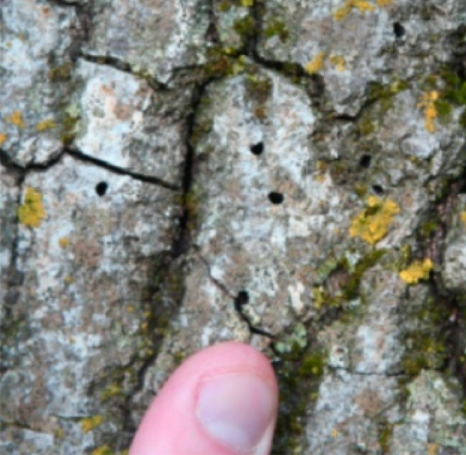
D-shaped GSOB exit holes. Credit: UC ANR
Ventura County is vulnerable to attack by the beetle and other invasive tree pests that are on watchlists for the area. Best ways of being assured your firewood is safe include purchasing locally source material or selecting kiln-dried or certified firewood.
For more information:
Report suspected GSOB infestation:
https://ucanr.edu/sites/gsobinfo/What_You_Can_Do/Report_GSOB_Symptoms/
Essential Read:
Invasive shot hole borers (ISHB) are tiny beetles that are posing a significant threat in Ventura County and beyond.
There's new information provided in this blog post by Wayne Farnsworth of BrightView Tree Care Services and Randall Oliver, UC ANR Integrated Pest Management Program. It appeared on the Channel Islands Chapter of the Community Association Institute website.
These pests are becoming established in parts of Ventura County. Farnsworth and Oliver note that "Unlike many insect pests, invasive shot hole borers infest a wide variety of tree species, including many common ornamentals, avocados and California natives. Sycamores and box elders are among their favorites, and they also attack live oaks, valley oaks and alders, all of which are abundant in our area."
Per UC ANR, invasive shot hole borers are
"two closely related species of small, non-native, beetles that bore into trees. ISHB introduce fungi that cause a tree disease called Fusarium dieback (FD). The ISHB-FD pest-disease complex is responsible for the death of thousands of trees in Southern California and poses an imminent threat to the integrity of our urban and natural forests.
Invasive shot hole borers attack a wide variety of tree species including avocados, common landscape selections, and California native species in urban and wildland environments."
You can learn more about ISHB at the UC ANR Integrated Pest Management website.
As Julie Di Blasio reported last year, "...invasive shot hole borer (ISHB) infestations have been identified in Ventura County since 2015 but have not significantly spread. Discovery of the pest/disease complex was found in late 2018 in the urban forest of Meiners Oaks. Citizens Journal recently published an article about the removal of a tree that was at risk for amplifying the local infestation and causing potential other community harm."
UCCE Ventura has been collaborating to address ISHB with UC insect, disease, education specialists, Ventura County Agricultural Commissioner, CAL FIRE, US Forest Service, several other agencies and non-government organizations. We are locally active in monitoring and outreach. Ventura County Master Gardeners Invasive Pests Outreach Group augments our work through their efforts to educate the public, firewood users and vendors."
Image credit: Akif Eskalen, UC Davis/UC ANR

Invasive shot hole borer on coin - Akif Eskalen
Proactive Biocontrol
Dr. Mark Hoddle will discuss the problems caused by invasive species in California. Invasion statistics of importance to California will be discussed along with relevant aspects of invasion biology that drive invasion pathways, establishment likelihood, and subsequent spread after establishment. One important management response is biological control and California is a world leader in this type of pest management. Problems caused by current high profile invaders (e.g., South American palm weevil), and biocontrol programs targeting destructive invasive pests (e.g., Asian citrus psyllid) will be discussed. Finally, a new twist on a classic approach will be presented, "Proactive Biocontrol." A proactive biocontrol program targeting spotted lanternfly, a pest not yet present in California, but one that is likely to establish and cause significant problems for the grape and nut industries will be discussed. One DPR CE unit (other) and one CCA CE unit (IPM) were requested.
Wednesday, Sept 9, 3-4 PM
UC Ag Experts Talk: What's in your Orchard: Protecting California from Invasive Species REGISTER HERE
And check out past and future offerings
What Are the UC Ag Experts Talking About?
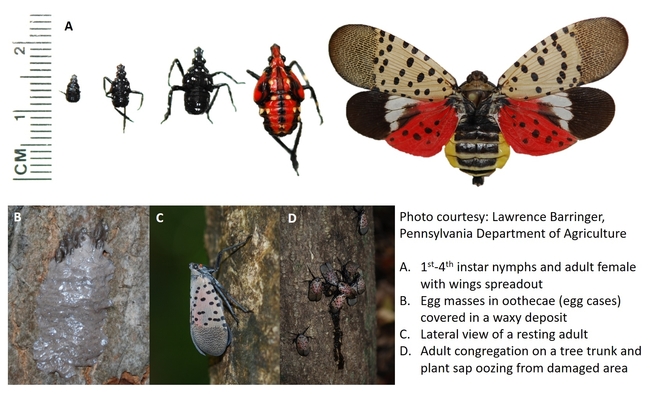
lantern fly life stages
USDA Investigating Packages of Mysterious Seeds
Have you had unexpected seeds show up in the mail? Unknown seeds could be invasive plants, contain invasive insects, or have plant disease causing agents. Here's what the United States Department of Agriculture Animal Plant and Health Inspection Service (USDA APHIS) has to say about it.
USDA Investigates Packages of Unsolicited Seeds
USDA is aware that people across the country have received suspicious, unsolicited packages of seed that appear to be coming from China. USDA's Animal and Plant Health Inspection Service (APHIS) is working closely with the Department of Homeland Security's Customs and Border Protection, other federal agencies, and State departments of agriculture to investigate the situation.
USDA urges anyone who receives an unsolicited package of seeds to immediately contact their State plant regulatory official or APHIS State plant health director. Please hold onto the seeds and packaging, including the mailing label, until someone from your State department of agriculture or APHIS contacts you with further instructions. Do not plant seeds from unknown origins.
At this time, [USDA does not] have any evidence indicating this is something other than a “brushing scam” where people receive unsolicited items from a seller who then posts false customer reviews to boost sales. USDA is currently collecting seed packages from recipients and will test their contents and determine if they contain anything that could be of concern to U.S. agriculture or the environment.
USDA is committed to preventing the unlawful entry of prohibited seeds and protecting U.S. agriculture from invasive pests and noxious weeds. Visit the APHIS' website to learn more about USDA's efforts to stop agricultural smuggling and promote trade compliance.
Cruel Vine
So I've gotten a few calls lately about this vine with a big green pod that is growing in lemon trees. What is done with it and how do you get rid of it?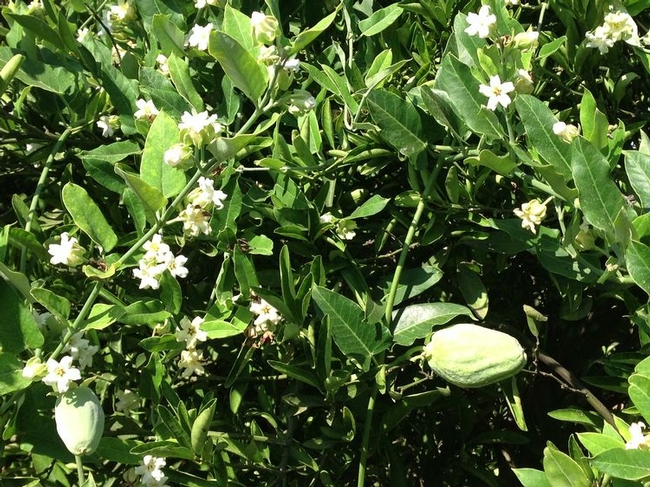
Araujia sericifera, cruel vine, moth plant, bladderflower is an escaped ornamental that has become an invasive weed in California. Yes, a pretty vine brought into the garden – “poor man's stephanotis” - and it's gotten out of the garden into southern California. It's in the hills, in abandoned orchards, on backyard fences and when it gets into a lemon tree, it takes some effort to remove it before the seeds spread to other trees and beyond.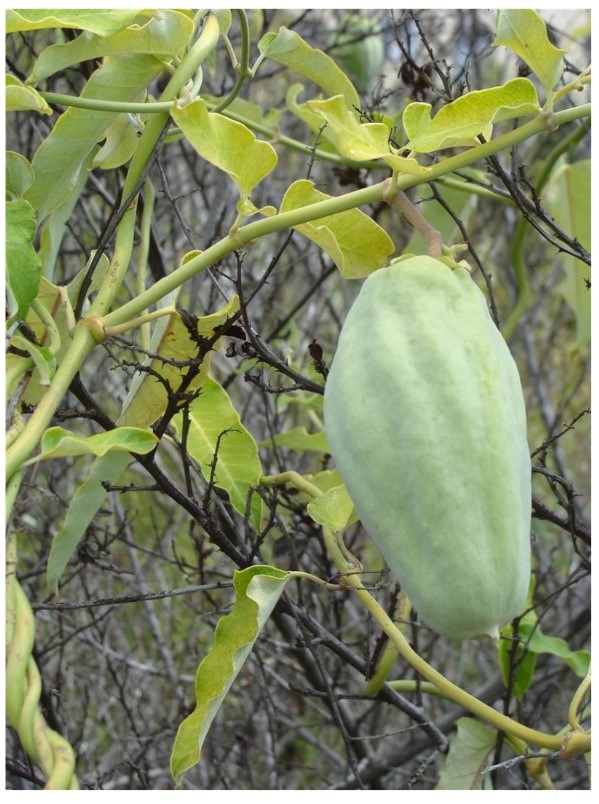
Bladderflower is a perennial vine that is very vigorous where it gets summer water. It is a common weed in citrus groves, where it would enshroud & smother entire trees if not controlled. Stems are tough and ropy, leaves thick & slightly spongy. Sap is milky white, moderately poisonous & causes skin irritation. It flowers Aug-Oct and the seed pods are obvious later in the fall. The flowers have a pleasant fragrance like jasmine. The reason for gardeners planting it. Plus it grows fast in our environment.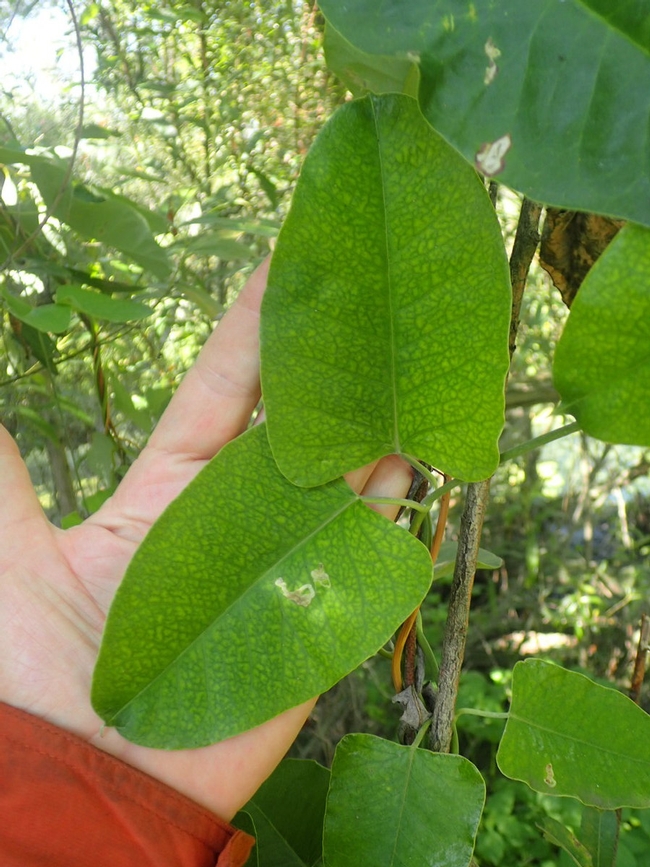
The plump pods produce copious seeds when ripe. The fruit splits down one side and turns itself inside out. The numerous, loosely attached seeds parachute away on silky hairs, dispersed by the wind – on to the next tree or fence.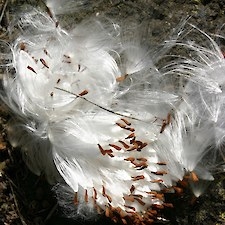
So the vine is entrained in the tree canopy so you cant spray an herbicide. To get rid of it, it's important to get down to the base of the tree and cut it out at ground level, removing as much of the root as possible. It still can regenerate, so it will be necessary to monitor the site, removing new growth as it might happen. Be sure to use hand protection because many people are allergic to the sap. Just cutting the vine at its base is sufficient to kill it. Removing the rest of the vine is necessary if there are pods, in order to prevent them going to seed.
The upside of the plant aside from the fragrant flowers is that it is an alternative food source for monarch butterfly caterpillars.
Calfflora shows cruel vine spread mostly along the coast south of San Luis Obispo, but it has the potential to spread thoguhout much of California. Currently, in the US, it is only found in California and Georgia. It is in New Zealand and Australia.
Calflora Description and Distribution of Bladderflower
USDA Description of Plant as attachment below:
Araujia sericifera WRA

